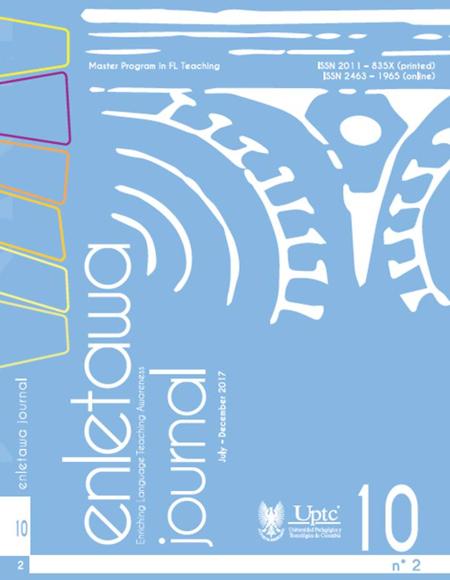Writing short stories to describe literary language use and perceptions as writer

Abstract
This qualitative case study aims at describing the process followed by ninth grade students at a private religious school when using and analyzing literary language. The instruments used to carry out this study were: students’ artifacts to identify and analyze the literary language used, field notes, and interviews. During this process, the learners as authors generated the construction of meaning and developed their competence in writing. The results show that students used metaphors and similes (literary features) to express ideas and details about their contexts in written production. In turn, students profited from the poetic function of the language where their voices as authors describe their perceptions and experiences as writers.
Keywords
Writing competence, literary language, perception as writers, short story
References
Anderson, A., and Jones, N. (1986). TAFE curriculum research: A review of group process methods. Adelaide: TAFE National Centre for Research and Development.
Bakhtin, M. (1981). The dialogic imagination (M. Holquist Ed.). Austin, TX: University of Texas Press.
Barton, D., and Hamilton, M. (2000). Literacy practices. In D. Barton, M. Hamilton, & R. Ivanovic (Eds.), Situated Literacies. Reading and Writing in Contexts (pp 7-15) London Routledge.
Bottomley, D. (1998). Assessing children’s views about themselves as writers using the Writer Self-Perception Scale. The Reading Teacher, 51(4), 286-296.
Butler, A., and Turbill, J. (1984). Towards a reading writing classroom. Portsmouth, NH: Heinemann.
Cassany, D. (1995). Describir el escribir, como se aprende a escribir. Barcelona: Paidos Iberica.
Dinneen, K., and O’Connor, M. (1983). Elements of the Short Story. Retrieved from: http://www.yale.edu/ynhti/curriculum/units/1983/3/83.03.09.x.html
Eco, U. (1981). Lector in fábula, la palabra en el tiempo. Barcelona: Lumen.
Eco, U. (1992). Interpretación y sobreinterpretacion de textos. Cambridge: Cambridge University Press.
Fokkema, D. (1985). The Concept of Code in the Study of Literature. Poetics Today, 6(4), 643-656
Freire, P. (1998). Pedagogy of freedom: Ethics, democracy, and civic courage (Clarke, P., Trans.). Maryland: Rowman & Littlefield.
Gee, J. P. (1991). What is literacy? Toronto: OISE Press.
Genette, G. (1989). Figuras III. Barcelona: Lumen.
Greenberg, K. (1987). Defining, teaching, and testing basic writing competence. Topics in Language Disorders, 7(4), 31-41.
Hemingway, E. (1987). The complete short stories of Ernest Hemingway. Finca Vigía Edition. New York: Scribner.
Hernández, R., Fernández, C., and Baptista, P. (2006). Metodología de la investigación (4th ed.). México: Mc Graw Hill.
Hicks, D. (1996). Contextual inquiries: A discourse-oriented study of classroom learning. Cambridge, MA: Cambridge University Press.
Hopkins, D. (1995). A Teacher’s Guide to Classroom Research. Buckingham, PA: Philadelphia Open University Press.
Hubbard, R., and Miller (1999). Living the questions: A guide for teachers-researchers. Maine: Stenhouse.
Jeffrey, B., and Craft, A. (2004) Creative practice and practice which fosters creativity in L. Miller and J. Devereux (Eds.) Supporting children’s learning in the early years (105-112). London: David Fulton.
Kennedy, J., and Gioia, G. (1999). Literature: An introduction to fiction, poetry, and drama. Ed. Harcourt.
Lazar, G. (1993). Literature and language teaching. Cambridge: Cambridge University press.
Liu, Y. (2009). The significance of structure in analyzing short stories. Asian Social Science Journal, 5 (8), 141-143
Merriam, S. (1985). The case study in educational research: A review of selected literature. Journal of Educational Thought, 19 (3), 204-217.
Miller, C. (1989). Writing Competency Statements in Communication. Edinburgh: Napier Polytechnic.
Mischler, E. G. (1986). Research interviewing. Context and narrative. Cambridge, MA: Harvard University Press.
Newton, J. (2001). Options for vocabulary learning through communication tasks. ELT Journal, 55 (1), 30-37.
O’Donoghue, B. (2001). What is literary language? (Why some words are more literary than others). A critical essay. The English Review, 4 (11) 28.
Osgood, C. (2005). The Measurement of Meaning. Urbana, IL: University of Illinois Press.
Pawlas, G.E. (1995). The structured interview: Three dozen questions to ask prospective teachers. NASSP Bulletin,79, 62-65.
Pennycook, A. (1989). The concept of method, interested knowledge, and the politics of language teaching. TESOL Quarterly, 23 (4), 589 – 618.
Poe, E. A. (1993). Tales of Mystery and Imagination (2nd ed.). Retold by Margaret Naudi. Oxford University Press: New York.
Quintero, N., Cortondo, P., Menéndez, T., and Posada, F. (1995). A la hora de leer y escribir…textos. Argentina: AIQUE.
Quiroga-Clare, C. (2003). Language ambiguity: A curse and a blessing. Translation Journal. 7(1), 57-61.
Recanati, F. (2001). Literal/Nonliteral. Midwest Studies in Philosophy, 25, 264- 274.
Sharples, M. (1996). An account of writing as creative design. Hillsdale, NJ: Lawrence Erlbaum
Tambling, J. (1988). What Is literary language? Michigan: Open University Press.
White, R., and Arndt, V. (1991). Process writing. London: Longman.
Wilde, O. (1981). The nightingale and the rose. London: Kaye & Ward.
Yin, R. (1989) Case Study Research: Design and Methods (rev. ed.). Beverly Hills, CA: Sage Publications.
Zonabend, F. (1992). The monograph in European ethnology. Current Sociology, 40 (1), 49-60.